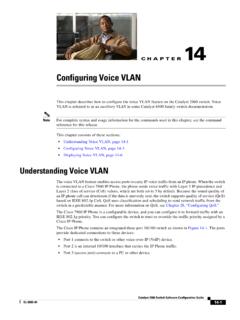Transcription of Configuring Q-in-Q VLAN Tunnels - Cisco
1 CHAPTERSend document comments to Nexus 7000 Series NX-OS Interfaces Configuration Guide, Release Q-in-Q VLAN TunnelsThis chapter describes how to configure IEEE ( Q-in-Q ) VLAN Tunnels and Layer 2 protocol tunneling on Cisco NX-OS chapter includes the following sections: Information About Q-in-Q Tunnels , page 9-1 Information About Layer 2 Protocol Tunneling, page 9-4 Licensing Requirements for Q-in-Q Tunnels , page 9-6 Guidelines and Limitations, page 9-6 Configuring Q-in-Q Tunnels and Layer 2 Protocol Tunneling, page 9-7 Verifying the Q-in-Q Configuration, page 9-15 Configuration Examples for Q-in-Q and Layer 2 Protocol Tunneling, page 9-15 Feature History for Q-in-Q Tunnels and Layer 2 Protocol Tunneling, page 9-16 Information About Q-in-Q TunnelsA Q-in-Q VLAN tunnel enables a service provider to segregate the traffic of different customers in their infrastructure, while still giving the customer a full range of vlans for their internal use by adding a second tag to an already tagged section includes the following topics.
2 Q-in-Q Tunneling, page 9-1 Native VLAN Hazard, page 9-3Q-in-Q TunnelingBusiness customers of service providers often have specific requirements for VLAN IDs and the number of vlans to be supported. The VLAN ranges required by different customers in the same service-provider network might overlap, and traffic of customers through the infrastructure might be mixed. Assigning a unique range of VLAN IDs to each customer would restrict customer configurations and could easily exceed the VLAN limit of 4096 of the document comments to Nexus 7000 Series NX-OS Interfaces Configuration Guide, Release 9 Configuring Q-in-Q VLAN TunnelsInformation About Q-in-Q TunnelsNoteQ-in-Q is supported on port channels and vPC. To configure a port channel as an asymmetrical link, all ports in the port channel must have the same tunneling the tunneling feature, service providers can use a single VLAN to support customers who have multiple vlans .
3 Customer VLAN IDs are preserved and traffic from different customers is segregated within the service-provider infrastructure even when they appear to be on the same VLAN. The tunneling expands VLAN space by using a VLAN-in-VLAN hierarchy and tagging the tagged packets. A port configured to support tunneling is called a tunnel port. When you configure tunneling, you assign a tunnel port to a VLAN that is dedicated to tunneling. Each customer requires a separate VLAN, but that VLAN supports all of the customer s traffic tagged in the normal way with appropriate VLAN IDs come from an trunk port on the customer device and into a tunnel port on the service-provider edge switch. The link between the customer device and the edge switch is an asymmetric link because one end is configured as an trunk port and the other end is configured as a tunnel port.
4 You assign the tunnel port interface to an access VLAN ID unique to each customer. See Figure Q-in-Q tunneling is not supported. All frames entering the tunnel port will be subject to Q-in-Q Tunnel PortsPackets entering the tunnel port on the service-provider edge switch, which are already with the appropriate VLAN IDs, are encapsulated with another layer of an tag that contains a VLAN ID unique to the customer. The original tag from the customer is preserved in the encapsulated packet. Therefore, packets that enter the service-provider infrastructure are double-tagged. The outer tag contains the customer s access VLAN ID (as assigned by the service provider), and the Customer AVLANs 1 to 100 Customer BVLANs 1 to 200 Customer BVLANs 1 to 200 Customer AVLANs 1 to 100 Tunnel portVLAN 40 Tunnel portVLAN 30 TrunkportsTrunkportsTunnel portVLAN 30 Tunnel portVLAN trunk trunk trunk trunk trunk port74016 TrunkAsymmetric linkTunnel portVLAN trunk trunk trunk trunk portSend document comments to Nexus 7000 Series NX-OS Interfaces Configuration Guide, Release 9 Configuring Q-in-Q VLAN TunnelsInformation About Q-in-Q Tunnelsinner VLAN ID is the VLAN of the incoming traffic (as assigned by the customer).
5 This double tagging is called tag stacking, Double-Q, or Q-in-Q as shown in Figure 9-2. Figure 9-2 Untagged, , and Double-Tagged Ethernet FramesBy using this method, the VLAN ID space of the outer tag is independent of the VLAN ID space of the inner tag. A single outer VLAN ID can represent the entire VLAN ID space for an individual customer. This technique allows the customer s Layer 2 network to extend across the service provider network, potentially creating a virtual LAN infrastructure over multiple tagging, that is multi-level dot1q tagging Q-in-Q , is not VLAN HazardWhen Configuring tunneling on an edge switch, you must use trunk ports for sending out packets into the service-provider network. However, packets that go through the core of the service-provider network might be carried through trunks, ISL trunks, or non-trunking links. When trunks are used in these core switches, the native vlans of the trunks must not match any native VLAN of the dot1q-tunnel port on the same switch because traffic on the native VLAN is not tagged on the transmitting trunk Figure 9-3, VLAN 40 is configured as the native VLAN for the trunk port from Customer X at the ingress edge switch in the service-provider network (Switch B).
6 Switch A of Customer X sends a tagged packet on VLAN 30 to the ingress tunnel port of Switch B in the service-provider network belonging to access VLAN 40. Because the access VLAN of the tunnel port (VLAN 40) is the same as the native VLAN of the edge-switch trunk port (VLAN 40), the tag is not added to tagged packets that are received from the tunnel port. The packet carries only the VLAN 30 tag through the service-provider network to the trunk port of the egress-edge switch (Switch C) and is misdirected through the egress switch tunnel port to Customer frame on trunk links betweenservice providernetwork frame fromcustomer networkOriginal Ethernet frameDestinationaddressLength/EtherTypeF rame CheckSequenceSourceaddressSADALen/EtypeD ataFCSSADALen/EtypeDataEtypeTa gFCSSADALen/EtypeDataEtypeTa gEtypeTa gFCS79831 Send document comments to Nexus 7000 Series NX-OS Interfaces Configuration Guide, Release 9 Configuring Q-in-Q VLAN TunnelsInformation About Layer 2 Protocol TunnelingFigure 9-3 Native VLAN HazardThese are a couple ways to solve the native VLAN problem.
7 Configure the edge switch so that all packets going out an trunk, including the native VLAN, are tagged by using the vlan dot1q tag native command. If the switch is configured to tag native VLAN packets on all trunks, the switch accepts untagged packets but sends only tagged packets. NoteThe vlan dot1q tag native command is a global command that affects the tagging behavior on all trunk ports. Ensure that the native VLAN ID on the edge switch trunk port is not within the customer VLAN range. For example, if the trunk port carries traffic of vlans 100 to 200, assign the native VLAN a number outside that range. Information About Layer 2 Protocol TunnelingCustomers at different sites connected across a service-provider network need to run various Layer 2 protocols to scale their topology to include all remote sites, as well as the local sites. The spanning Tree Protocol (STP) must run properly, and every VLAN should build a proper spanning tree that includes the local site and all remote sites across the service-provider infrastructure.
8 Cisco Discovery Protocol (CDP) must be able to discover neighboring Cisco devices from local and remote sites, and the VLAN Trunking Protocol (VTP) must provide consistent VLAN configuration throughout all sites in the customer portVLANs 30-40 Native VLAN 40 Tunnel portAccess VLAN 30 Tunnel portServiceproviderTag not addedfor VLAN 40Ta gremovedVLANs 5-50 Switch DCustomer XVLANs 30-40 Native VLAN 40 Switch BSwitch CQQS witch ECustomer YSwitch ACustomer XNativeVLAN 40101820 TrunkAsymmetric linkCorrect path for trafficIncorrect path for traffic due tomisconfiguration of native VLANby sending port on Switch BQ = trunk portsTunnel portAccess VLAN 40 Packet taggedfor VLAN 30 VLAN 40 Send document comments to Nexus 7000 Series NX-OS Interfaces Configuration Guide, Release 9 Configuring Q-in-Q VLAN TunnelsInformation About Layer 2 Protocol TunnelingWhen protocol tunneling is enabled.
9 Edge switches on the inbound side of the service-provider infrastructure encapsulate Layer 2 protocol packets with a special MAC address and send them across the service-provider network. Core switches in the network do not process these packets, but forward them as normal packets. Bridge protocol data units (BPDUs) for CDP, STP, or VTP cross the service-provider infrastructure and are delivered to customer switches on the outbound side of the service-provider network. Identical packets are received by all customer ports on the same protocol tunneling is not enabled on tunneling ports, remote switches at the receiving end of the service-provider network do not receive the BPDUs and cannot properly run STP, CDP, , and VTP. When protocol tunneling is enabled, Layer 2 protocols within each customer s network are totally separate from those running within the service-provider network.
10 Customer switches on different sites that send traffic through the service-provider network with tunneling achieve complete knowledge of the customer s 2 protocol tunneling works by tunneling BPDUs in software. A large number of BPDUs coming into the SUP will cause the CPU load to go up. You may need to make use of hardware rate limiters to reduce the load on the SUP CPU. See the Configuring the Rate Limit for Layer 2 Protocol Tunnel Ports section on page example, in Figure 9-4, Customer X has four switches in the same VLAN that are connected through the service-provider network. If the network does not tunnel BPDUs, switches on the far ends of the network cannot properly run the STP, CDP, , and VTP protocols. Figure 9-4 Layer 2 Protocol TunnelingCu st o m e r X Si t e 1 vlans 1 to 100 Send document comments to Nexus 7000 Series NX-OS Interfaces Configuration Guide, Release 9 Configuring Q-in-Q VLAN TunnelsLicensing Requirements for Q-in-Q TunnelsIn the preceding example, STP for a VLAN on a switch in Customer X, Site 1 will build a spanning tree on the switches at that site without considering convergence parameters based on Customer X s switch in Site 2.











